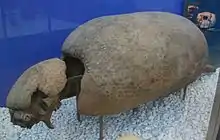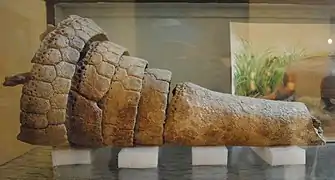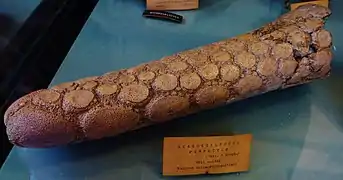Neosclerocalyptus
Neosclerocalyptus was an extinct genus of glyptodont that lived during the Pleistocene in northeastern Argentina.[1]
| Neosclerocalyptus | |
|---|---|
 | |
| Fossil in Valencia | |
| Scientific classification | |
| Kingdom: | Animalia |
| Phylum: | Chordata |
| Class: | Mammalia |
| Order: | Cingulata |
| Family: | Chlamyphoridae |
| Subfamily: | †Glyptodontinae |
| Genus: | †Neosclerocalyptus Couto, 1957 |
| Species | |
| |
| Synonyms | |
| |
Species
The species known for this genus are:[2]
- N. castellanosi[3] Zurita et al., 2013
- N. gouldi Zurita et al. 2008
- N. heusseri (Ameghino, 1889)
- N. ornatus (Owen, 1845) (type species)
- N. paskoensis Zurita 2002
- N. pseudornatus (Ameghino, 1889)
Distribution
Fossils of Neosclerocalyptus have been found in:[4]
- Miramar, Yupoí, Agua Blanca, Buenos Aires, and Luján Formations, Argentina
Gallery
 Tail armour
Tail armour Tail armour
Tail armour
References
- Zurita, A. E.; Scarano, A. C.; Carlini, A. A.; Scillato-Yané, G. J.; Soibelzon, E. (2011). "Neosclerocalyptus spp. (Cingulata: Glyptodontidae: Hoplophorini): Cranial morphology and palaeoenvironments along the changing Quaternary". Journal of Natural History. 45 (15–16): 893. doi:10.1080/00222933.2010.536917.
- A. E. Zurita, A. A. Carlini, and G. J. Scillato-Yané. 2009. Paleobiogeography, biostratigraphy and systematics of the Hoplophorini (Xenarthra, Glyptodontoidea, Hoplophorinae) from the Ensenadan Stage (early Pleistocene to early-middle Pleistocene). Quaternary International 210:82-92.
- Alfredo E. Zurita, Matias Taglioretti, Martin Zamorano, Gustavo J. Scillato-Yané, Carlos Luna, Daniel Boh & Mariano Magnussen Saffer. 2013. A new species of Neosclerocalyptus Paula Couto (Mammalia: Xenarthra: Cingulata): the oldest record of the genus and morphological and phylogenetic aspects. Zootaxa 3721 (4): 387–398.
- Neosclerocalyptus at Fossilworks.org
This article is issued from Wikipedia. The text is licensed under Creative Commons - Attribution - Sharealike. Additional terms may apply for the media files.